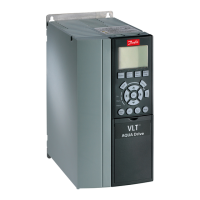7-35 Process PID Dierentiation Time
Range: Function:
0 s* [0 - 10 s] Enter the PID dierentiation time.
The dierentiator does not react to
a constant error, but provides a
gain only when the error changes.
The shorter the PID dierentiation
time, the stronger the gain from
the dierentiator.
7-36 Process PID Di. Gain Limit
Range: Function:
5* [1 - 50] Enter a limit for the dierentiator
gain. If there is no limit, the dier-
entiator gain increases when there
are fast changes. To obtain a pure
dierentiator gain at slow changes
and a constant dierentiator gain
where fast changes occur, limit the
dierentiator gain.
7-38 Process PID Feed Forward Factor
Range: Function:
0 %* [0 - 200 %] Enter the PID feed forward factor.
The factor sends a constant fraction
of the reference signal to bypass
the PID control, so the PID control
only aects the remaining fraction
of the control signal. Any change to
this parameter aects the motor
speed. When the feed forward
factor is activated, it provides less
overshoot and high dynamics when
changing the setpoint.
Parameter 7-38 Process PID Feed
Forward Factor is active when
parameter 1-00 Conguration Mode
is set to [3] Process.
7-39 On Reference Bandwidth
Range: Function:
5 %* [0 - 200 %] Enter the on-reference bandwidth.
When the PID control error (the
dierence between the reference
and the feedback) is less than the
value of this parameter, the on-
reference status bit is 1.
4.8.4 7-4* Advanced Process PID Ctrl.
This parameter group is only used if parameter 1-00 Cong-
uration Mode is set to [7] Extended PID speed CL.
7-40 Process PID I-part Reset
Option: Function:
[0] * No
[1] Yes Select [1] Yes to reset the I-part of
the process PID controller. The
selection automatically returns to
[0] No. Resetting the I-part makes it
possible to start from a well-
dened point after changing
something in the process, for
example changing a textile roll.
7-41 Process PID Output Neg. Clamp
Range: Function:
-100 %* [ -100 - par.
7-42 %]
Enter a negative limit for the
process PID controller output.
7-42 Process PID Output Pos. Clamp
Range: Function:
100 %* [ par. 7-41 -
100 %]
Enter a positive limit for the process
PID controller output.
7-43 Process PID Gain Scale at Min. Ref.
Range: Function:
100 %* [0 - 100 %] Enter a scaling percentage to apply
to the process PID output when
operating at the minimum
reference. The scaling percentage is
adjusted linearly between the scale
at minimum reference
(parameter 7-43 Process PID Gain
Scale at Min. Ref.) and the scale at
maximum reference
(parameter 7-44 Process PID Gain
Scale at Max. Ref.).
7-44 Process PID Gain Scale at Max. Ref.
Range: Function:
100 %* [0 - 100 %] Enter a scaling percentage to apply
to the process PID output when
operating at the maximum
reference. The scaling percentage is
adjusted linearly between the scale
at minimum reference
(parameter 7-43 Process PID Gain
Scale at Min. Ref.) and the scale at
maximum reference
(parameter 7-44 Process PID Gain
Scale at Max. Ref.).
Parameter Descriptions Programming Guide
MG06J202 Danfoss A/S © 03/2019 All rights reserved. 91
4 4

